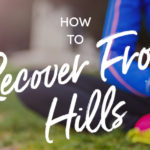By Hayden Shearman // The obvious answer to the question above is that something in your body—whether it be bone or soft tissue—can’t handle the stress you’re putting it under. For distance runners, that stress isn’t usually from a one-off exertion but a small repeated exertion over time. In other words, running injuries are usually repetitive strain injuries.

So just like your finger might get sore from double clicking your mouse too much in one day, running injuries happen when we simply do too much running in relation to what our bodies have adapted to. Too much distance, too much speed or too many hills, all too soon—that’s why runners get injured.
You’re probably thinking, “Well, this isn’t exactly groundbreaking information you’re giving us, Hayden!” And you’re right, it’s just commonsense. But what I want to put under the microscope are the mental processes and habits of thinking that lead us to making those mistakes of too much too soon. Because if “don’t do too much too soon” is commonsense, why are 80% of us getting injured each year?
If we have a half decent training plan it should have the following tried and tested commonsense rules of:
- not increasing mileage more than 10%,
- only introducing one new training stress per week (and doing this gradually),
- taking rest and/or easy days each week,
- taking easy weeks each month,
- taking easy months twice per year,
- being proactive each week with intentional recovery & pre-hab (foam rolling, ice baths, eating and sleeping well, calf raises, massage, glute strengthening—or whatever works best for you), and
- understanding your own body well enough to tweak these rules to suit.
These are simple rules to live by. And, hand-on-heart, having coached 100s of runners over the years, I would say that 9 out of 10 running injuries could be avoided if we followed these basics. But that’s our great weakness as runners, we know what we should do, but we still don’t do it.
And I’m ultimately looking in the mirror when I say this!
I’m injured right now.
It’s the same dodgy left achilles that has plagued my entire running career. For the past three years it’s flared up about every six months. The cycle goes like this:
- One month with very little running, lots of rehab and conditioning.
- Three months of gradually building up the mileage and workout intensities, with lots of pre-hab, intentional recovery and gym conditioning.
- Two months of feeling like my younger fitter self again: cranking out the miles, smashing hard workouts, fizzing on my improving fitness, fitting in extra runs or effort sessions whenever I can, skipping gym workouts to log more miles, switching “easy” weeks into “speed” or “race” weeks, not enough time for foam rolling … next minute … I’m walking back from a run, inflamed, injured, kicking myself.
I’m realising that the chronic injury isn’t so much the achilles. Sure, it will perhaps always limit my mileage and change the 10% rule to the 5% rule and require more gym time and intentional recovery, but I should have the intelligence and mental fortitude to work around those restrictions and avoid flaring up old injuries. I’ve come to the conclusion that the chronic injury is actually more my mindset.
So, what can I do to pre-hab and strengthen that mindset? How can I ensure that when I get back to a solid level of fitness again I can maintain those positive training rules that got me there in the first place?
This is where I need to question some of my core beliefs about fitness that I tend to adopt even though I know they are actually myths. And these, for me, are the following:
- More is always better. This is a half truth in that more mileage does make you a better runner—up to a certain point and then you get diminishing returns and then eventually negative returns. But the important shift in mindset that I know I need to consistently make is that, more running also requires more intentional recovery, more rest, more pre-hab, more sleep and less life stress. When you sacrifice more running for less recovery, you’re headed for injury city.
- Improvement is linear. Think back to when in a training cycle you’ve felt the fittest. Is it the day after a hard workout? No, you feel trashed and stiff all over. Is it in the middle of a big mileage block? No, you’re run down and on the limit of what your body can handle. We all know that we are most fit once we’ve gone through that full cycle of adequate training stress followed by adequate recovery. It’s why we taper and why we periodise our training calendars into hard weeks and months and easy weeks and months. Realising there will be times when you feel sluggish and times when you will put on weight and times when you feel full of bounce and times when you’re dropping pounds, is the ultimate in fitness maturity. Improvement is a very wiggly line that trends up over months and years—always remember the importance of the wiggle!
- Resting isn’t getting fitter. It follows from the above that training stress and recovery are two sides to the same coin. So much so, that for most dedicated runners, the best thing we can do for our fitness is to actually take a rest day! We need to free ourselves of that daily (or even weekly) addiction to feeling absolutely worked at the end of a run or a session. As mature runners, we need to bottle up that desire for an epic training or racing day for those key sessions when it really counts so that we can schedule in those all-important rest and recovery days.
What core beliefs do you hold about your fitness that you know, deep down, are negatively affecting your ability to grow as a runner? And what causes you to let slip on sticking to those basic, commonsense rules of running training?
These are tough questions to ask, but can save us plenty of stress and physio visits!!
Happy running.



